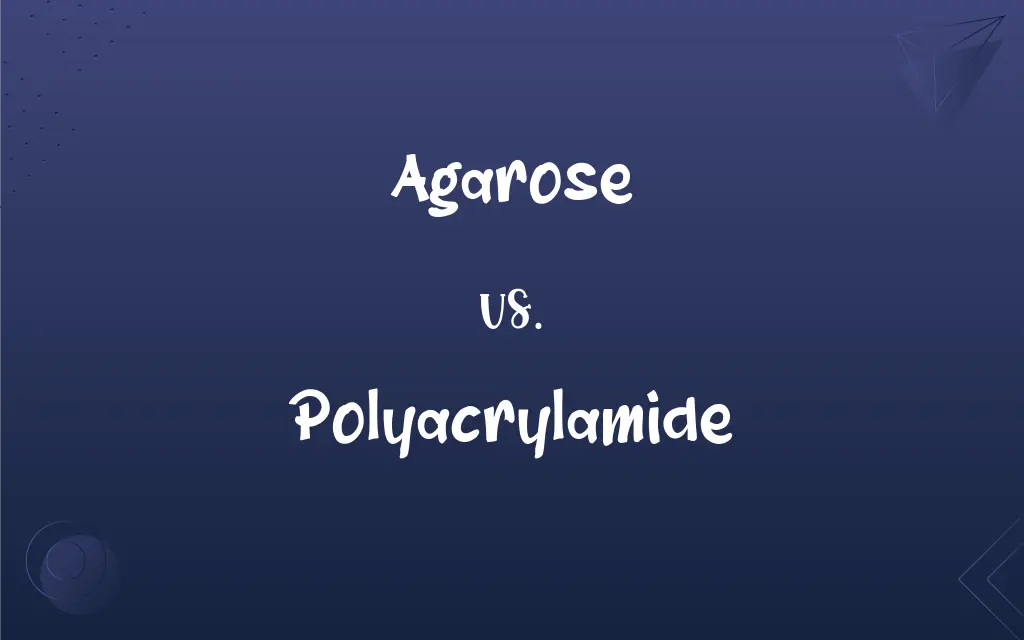Agarose vs. Polyacrylamide: What's the Difference?
Edited by Aimie Carlson || By Harlon Moss || Published on February 24, 2024
Agarose is a polysaccharide used primarily for gel electrophoresis of DNA. Polyacrylamide is a polymer used in gel electrophoresis, particularly for proteins.

Key Differences
Agarose is a natural polysaccharide, extracted from seaweed, and commonly used in gel electrophoresis for DNA and RNA separation. Polyacrylamide, a synthetic polymer, is also used in electrophoresis but is particularly suited for separating proteins due to its finer pore size.
The structure of agarose allows for the formation of larger pores, making it ideal for the separation of larger DNA fragments. Polyacrylamide gels have smaller pores, allowing for the resolution of smaller molecules, like proteins and smaller DNA or RNA fragments.
Agarose gels are generally easier to prepare and handle, with a lower risk of toxicity compared to polyacrylamide. Polyacrylamide gels, however, require more careful handling due to the neurotoxic nature of unpolymerized acrylamide.
In DNA electrophoresis, agarose provides a broad range of separation, but with lower resolution than polyacrylamide. Polyacrylamide is preferred for techniques requiring high resolution, such as DNA sequencing or SDS-PAGE for protein analysis.
Agarose gels are typically used for routine DNA analysis and size-based separation. Polyacrylamide, due to its complexity and sensitivity, is more often employed in research and diagnostic laboratories for precise molecular work.
ADVERTISEMENT
Comparison Chart
Source
Natural polysaccharide from seaweed
Synthetic polymer
Pore Size
Larger, for bigger molecules
Smaller, for finer separation
Use
DNA and RNA electrophoresis
Protein and small DNA/RNA electrophoresis
Ease of Preparation
Easier to prepare and less toxic
Requires careful handling due to toxicity
Application in Electrophoresis
Better for larger DNA fragments
Preferred for high-resolution applications
ADVERTISEMENT
Agarose and Polyacrylamide Definitions
Agarose
It is less toxic compared to other electrophoresis gels.
Agarose is preferred in educational settings due to its lower toxicity.
Polyacrylamide
Polyacrylamide is a polymer used for protein and small molecule electrophoresis.
SDS-PAGE, which uses polyacrylamide gels, is essential for protein analysis.
Agarose
Agarose is a gel-forming polysaccharide used in DNA electrophoresis.
Agarose gels are a standard tool for assessing DNA fragment sizes in laboratories.
Polyacrylamide
It forms gels with smaller pores than agarose.
Polyacrylamide gels can separate proteins based on very small differences in size.
Agarose
Agarose gels are used for routine analysis of DNA.
Gel electrophoresis using agarose is a common technique for DNA fingerprinting.
Polyacrylamide
Polyacrylamide is used for high-resolution electrophoresis.
DNA sequencing often requires the precision of polyacrylamide gels.
Agarose
Agarose is known for its ease of use in gel electrophoresis.
Researchers often choose agarose for quick DNA separation tasks.
Polyacrylamide
The handling of polyacrylamide requires caution due to toxicity.
Researchers must wear protective gear when preparing polyacrylamide gels.
Agarose
Extracted from seaweed, agarose forms a matrix with large pores.
Larger DNA molecules migrate more slowly through an agarose gel.
Polyacrylamide
Polyacrylamide is synthetic and widely used in molecular biology research.
The study of protein-protein interactions often employs polyacrylamide gel electrophoresis.
Agarose
A polysaccharide obtained from agar that is the most widely used medium for gel electrophoresis procedures.
Polyacrylamide
A water-soluble white solid polyamide, (-CH2CHCONH2-), related to acrylic acid.
Agarose
A polymeric cross-linked polysaccharide extracted from the seaweed agar; used to make gels that are used in electrophoresis.
Polyacrylamide
(organic compound) Any of a range of cross-linked polymers of acrylamide; used to form soft gels for making contact lenses etc.
FAQs
Is agarose natural or synthetic?
Agarose is a natural substance, extracted from seaweed.
Is polyacrylamide toxic?
Yes, particularly in its unpolymerized form.
What is agarose?
A polysaccharide used in gel electrophoresis for DNA and RNA.
What is polyacrylamide?
A polymer used in electrophoresis, especially for proteins.
What's the main use of agarose gels?
For separating DNA and RNA fragments.
What's the advantage of using polyacrylamide in DNA sequencing?
Its high resolution allows for precise separation of small DNA fragments.
How is agarose prepared for electrophoresis?
By dissolving it in a buffer solution and heating.
What safety precautions are needed for polyacrylamide?
Use of gloves and protective equipment due to its toxicity.
Why is agarose preferred for larger DNA fragments?
Its larger pore size allows easier migration of big molecules.
What are the disadvantages of using agarose?
Lower resolution compared to polyacrylamide.
Can polyacrylamide gels be reused?
Generally, they are not reused due to contamination risks.
Why is polyacrylamide used in protein analysis?
Its smaller pores allow for finer separation of proteins.
Can agarose separate small DNA fragments effectively?
It's less effective for very small fragments compared to polyacrylamide.
Is polyacrylamide gel electrophoresis more complex than agarose?
Yes, it requires more careful preparation and handling.
Can polyacrylamide gels be used for large DNA fragments?
It's not ideal due to their smaller pore size.
Is the resolution of agarose sufficient for routine DNA analysis?
Yes, for most routine applications, agarose provides adequate resolution.
Are there alternatives to agarose for DNA electrophoresis?
Polyacrylamide can be an alternative, especially for smaller fragments.
What's the role of SDS in polyacrylamide gel electrophoresis?
SDS denatures proteins, allowing them to separate based on size.
Can agarose be used for protein electrophoresis?
It's possible, but not as effective as polyacrylamide for most proteins.
How do the costs of agarose and polyacrylamide compare?
Agarose is generally less expensive and easier to handle.
About Author
Written by
Harlon MossHarlon is a seasoned quality moderator and accomplished content writer for Difference Wiki. An alumnus of the prestigious University of California, he earned his degree in Computer Science. Leveraging his academic background, Harlon brings a meticulous and informed perspective to his work, ensuring content accuracy and excellence.
Edited by
Aimie CarlsonAimie Carlson, holding a master's degree in English literature, is a fervent English language enthusiast. She lends her writing talents to Difference Wiki, a prominent website that specializes in comparisons, offering readers insightful analyses that both captivate and inform.































































